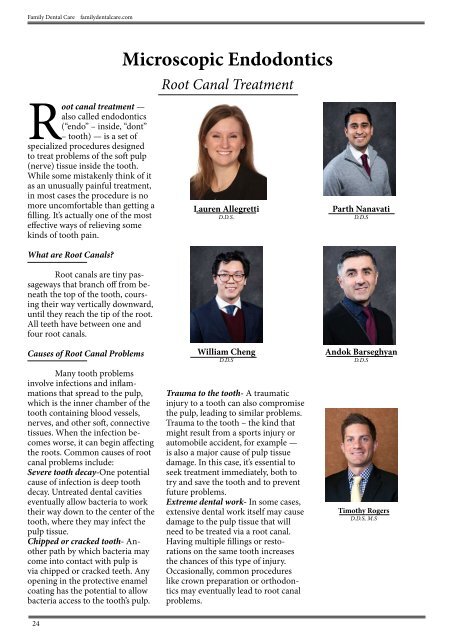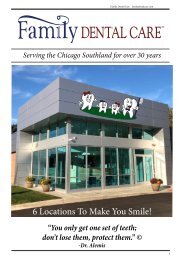Family Dental Care™ Magazine (2021 Edition)
2021 Edition from Family Dental Care™ in Chicago's Southland and NW Indiana
2021 Edition from Family Dental Care™ in Chicago's Southland and NW Indiana
Create successful ePaper yourself
Turn your PDF publications into a flip-book with our unique Google optimized e-Paper software.
<strong>Family</strong> <strong>Dental</strong> Care familydentalcare.com <strong>Family</strong> <strong>Dental</strong> Care familydentalcare.com<br />
Microscopic Endodontics<br />
Root Canal Treatment<br />
Root canal treatment —<br />
also called endodontics<br />
(“endo” – inside, “dont”<br />
– tooth) — is a set of<br />
specialized procedures designed<br />
to treat problems of the soft pulp<br />
(nerve) tissue inside the tooth.<br />
While some mistakenly think of it<br />
as an unusually painful treatment,<br />
in most cases the procedure is no<br />
more uncomfortable than getting a<br />
filling. It’s actually one of the most<br />
effective ways of relieving some<br />
kinds of tooth pain.<br />
What are Root Canals?<br />
Root canals are tiny passageways<br />
that branch off from beneath<br />
the top of the tooth, coursing<br />
their way vertically downward,<br />
until they reach the tip of the root.<br />
All teeth have between one and<br />
four root canals.<br />
Causes of Root Canal Problems<br />
Many tooth problems<br />
involve infections and inflammations<br />
that spread to the pulp,<br />
which is the inner chamber of the<br />
tooth containing blood vessels,<br />
nerves, and other soft, connective<br />
tissues. When the infection becomes<br />
worse, it can begin affecting<br />
the roots. Common causes of root<br />
canal problems include:<br />
Severe tooth decay-One potential<br />
cause of infection is deep tooth<br />
decay. Untreated dental cavities<br />
eventually allow bacteria to work<br />
their way down to the center of the<br />
tooth, where they may infect the<br />
pulp tissue.<br />
Chipped or cracked tooth- Another<br />
path by which bacteria may<br />
come into contact with pulp is<br />
via chipped or cracked teeth. Any<br />
opening in the protective enamel<br />
coating has the potential to allow<br />
bacteria access to the tooth’s pulp.<br />
Lauren Allegretti<br />
D.D.S.<br />
William Cheng<br />
D.D.S<br />
Trauma to the tooth- A traumatic<br />
injury to a tooth can also compromise<br />
the pulp, leading to similar problems.<br />
Trauma to the tooth – the kind that<br />
might result from a sports injury or<br />
automobile accident, for example —<br />
is also a major cause of pulp tissue<br />
damage. In this case, it’s essential to<br />
seek treatment immediately, both to<br />
try and save the tooth and to prevent<br />
future problems.<br />
Extreme dental work- In some cases,<br />
extensive dental work itself may cause<br />
damage to the pulp tissue that will<br />
need to be treated via a root canal.<br />
Having multiple fillings or restorations<br />
on the same tooth increases<br />
the chances of this type of injury.<br />
Occasionally, common procedures<br />
like crown preparation or orthodontics<br />
may eventually lead to root canal<br />
problems.<br />
Parth Nanavati<br />
D.D.S<br />
Andok Barseghyan<br />
D.D.S<br />
Timothy Rogers<br />
D.D.S, M.S<br />
24 25




